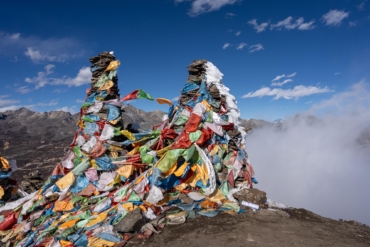Nepali officials have uncovered an apparent scam. The con artists faked government documents, sent unapproved climbers up Everest, and pocketed thousands in permit fees.

Just when you thought things couldn’t get any weirder on Mt. Everest, we get news of yet another mountaineering controversy that prominently features the world’s highest peak.
Last week, Nepal’s Department of Tourism (DoT) revealed its discovery. One of the guide services operating on the mountain had issued two forged climbing permits for the spring 2018 season. Apparently, someone pocketed the thousands of dollars climbers pay for those documents.
According to The Himalayan Times, the fraudulent permits were issued to James Hibbert of Australia and Xu Zhong Zhou of China. Each climber paid $11,000 for the documents, which allowed them to join the 14 Peak Experience Everest Expedition. And that climb was organized and supported by Seven Summit Treks — one of the top mountaineering companies based in Nepal.
Seven Summit Treks: Fraudulent Everest Permits
While reviewing records of the 2018 spring climbing season, DoT officials noticed a discrepancy between their records and those kept by Seven Summit Treks. The original permits issued on April 13 included just 12 climbers, while another permit issued on the same day includes the names of Hibbert and Zhou. That second version uses counterfeit DoT letterhead and a fake government seal, giving it the appearance of an official document.
Climbing without a permit in Nepal is a serious offense. It can lead to the country barring entry to mountaineers for years. In this case, however, there is no indication that Hibbert or Zhou had any knowledge of the fake documents. The Chinese alpinist reportedly went on to summit Everest, while the Australian apparently abandoned his attempt after reaching Camp II at 21,000 feet.
Seven Summit Treks owner Mingma Sherpa acknowledges that Hibbert and Zhou were part of the expedition. He says he had no knowledge of the fake permits, telling The Times that his company is “ready to cooperate with the investigation of the probe panel.”
DoT officials indicated that an investigation into the fake permits is now underway. A forensic specialist is evaluating the documents in an effort to confirm or deny their authenticity. Next, a three-person committee will review the findings and make a ruling based on the evidence at a later time.
Fake Everest Climbing Permits: Who’s to Blame?
Sherpa told the Times he believes a representative of his company is responsible for forging the permits and pocketing $22,000 in climbing fees. That employee is most likely a liaison between the company and the DoT, handling the extensive paperwork required for Everest expeditions. The DoT requires copies of passports, climbing resumes, insurance, and a host of other documents, closely examining each.
Nepal is no stranger to controversy when it comes to Mt. Everest. From fake summits to dubious records, the mountain has always been a magnet for frauds and hucksters.
However, the Nepali government routinely contributes to this problem as well. For example, mountaineering regulations require climbers to cover expenses of liaison officers. A liaison officer’s job is to lead climbing teams to base camp, facilitate communications with the DoT back in Kathmandu, oversee rescue and evacuation operations, and provide government support to the mountaineers.
But studies indicate that 90 percent of those officers never actually go to base camp. Often, their fees disappear somewhere into the government’s coffers.







